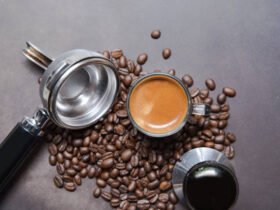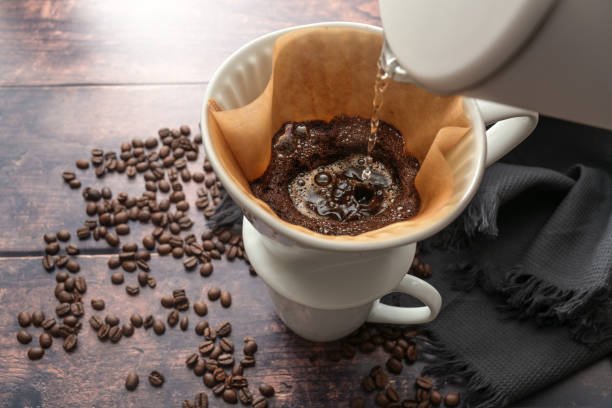If you’re a tea lover or coffee connoisseur, you might have asked yourself, “Can I use coffee beans for espresso?” This question may arise as you explore the vast world of coffee and its various brewing methods. The short answer is yes, but there’s more to it than simply tossing coffee beans into an espresso machine. This blog post will guide you through the nuances of using coffee beans for espresso, offering insights, tips, and valuable information to help you get the best out of your espresso experience.
Understanding Espresso
What Makes Espresso Unique?
Espresso is a concentrated form of coffee brewed by forcing hot water through finely-ground coffee beans. This method produces a rich, robust flavor with a creamy texture, known as crema. Unlike other coffee brewing methods, espresso is all about precision— from the grind size to the water temperature and pressure.
The Role of Coffee Beans in Espresso
The type of coffee bean you use significantly impacts the quality of your espresso. While any coffee bean can technically be used, some are better suited for espresso due to their flavor profiles and roast levels. Typically, darker roasts are preferred because they offer a richer, more robust flavor that stands up well to the intensity of the espresso brewing process.
Types of Coffee Beans Suitable for Espresso
Arabica vs. Robusta
Arabica and Robusta are the two primary types of coffee beans used in coffee making. Arabica beans are known for their smooth, nuanced flavors and are often considered superior. Robusta beans, on the other hand, are stronger and more bitter, making them ideal for adding a bit of punch to your espresso.
Single-Origin vs. Blends
Single-origin beans come from a specific region and offer unique flavors characteristic of their origin. Blends, however, combine beans from different regions to create a balanced flavor profile. Both can be used for espresso, but blends are often preferred for their consistency and complexity.
Decaffeinated Options
For those who love the taste of espresso but want to avoid caffeine, decaffeinated coffee beans are a great option. They undergo a process to remove most of the caffeine while retaining their flavor.
How to Choose the Right Beans for Espresso
Flavor Profiles to Look For
When choosing beans for espresso, look for flavor profiles that include chocolate, caramel, and nutty notes. These flavors are enhanced during the espresso brewing process, resulting in a rich and satisfying cup.
Importance of Freshness
Freshly roasted beans make all the difference in flavor and aroma. Always check the roast date and aim to use beans within a month of roasting for the best results.
Roasting Levels
While dark roasts are traditional for espresso, medium roasts can also be used to highlight different flavor notes. Light roasts are generally not recommended as they can taste too acidic and lack the body needed for a good espresso.
Preparing Your Beans for Espresso
Grinding Your Beans
The grind size is crucial for making espresso. Too coarse, and the water will flow through too quickly, resulting in a weak shot. Too fine, and the water will struggle to pass through, leading to over-extraction and bitterness. A fine, consistent grind is key.
Storing Your Beans
Proper storage extends the freshness of your beans. Keep them in an airtight container away from light, heat, and moisture. Avoid storing them in the fridge or freezer as this can introduce moisture.
Weighing Your Beans
Precision matters in espresso making. Use a digital scale to measure your beans accurately. Typically, a single shot requires about 7-9 grams of coffee, while a double shot uses 14-18 grams.
Brewing the Perfect Espresso
Setting Up Your Espresso Machine
Ensure your espresso machine is clean and properly maintained. Check the water temperature settings (ideally between 195-205°F) and the pressure (around 9 bars) to ensure optimal extraction.
Tamping Your Coffee Grounds
Tamping is the process of pressing the coffee grounds evenly into the portafilter. Use a consistent and firm pressure to create an even surface, which helps in the even extraction of coffee.
Pulling the Shot
Once you’ve prepared your portafilter, lock it into the machine and start the extraction. Aim for a shot time of 25-30 seconds for a balanced flavor. Adjust the grind size or tamping pressure if the shot time is too short or too long.
Coffee Mate French Vanilla Liquid Coffee Creamer

- Gluten Free
- Coffee-mate
- French Vanilla
- Liquid
Enhancing Your Espresso Experience
Experimenting with Different Beans
Don’t be afraid to experiment with different beans to find your perfect espresso. Try single-origin beans for unique flavors or blends for a balanced profile.
Adding Milk and Sweeteners
While purists may prefer their espresso straight, adding milk or sweeteners can create delicious variations like cappuccinos, lattes, and macchiatos.
Pairing with Food
Espresso pairs beautifully with a variety of foods, from sweet pastries to savory snacks. Experiment with pairings to enhance your coffee experience.
Common Mistakes to Avoid
Using Old Beans
Old beans lose their flavor and aroma, leading to a dull espresso. Always use fresh beans to get the best results.
Incorrect Grind Size
An incorrect grind size can ruin your espresso. Invest in a good quality grinder and take the time to dial in the perfect grind.
Neglecting Machine Maintenance
Regular maintenance of your espresso machine ensures consistent performance and longevity. Clean the machine regularly and follow the manufacturer’s maintenance guidelines.
FAQs About Coffee Beans and Espresso
Can I use any coffee beans for espresso?
Yes, you can technically use any coffee beans for espresso, but some beans are better suited due to their flavor profiles and roast levels.
What is the best roast level for espresso?
Dark roasts are traditionally used for espresso, but medium roasts can also be suitable. Light roasts are generally not recommended.
How important is the grind size for espresso?
Grind size is crucial for making good espresso. A fine, consistent grind is essential for proper extraction.
Can I use decaffeinated beans for espresso?
Yes, decaffeinated beans can be used for espresso. They undergo a process to remove most of the caffeine while retaining their flavor.
How should I store my coffee beans?
Store your coffee beans in an airtight container away from light, heat, and moisture. Avoid storing them in the fridge or freezer.
Conclusion
Using coffee beans for espresso opens up a world of possibilities for coffee lovers. By understanding the nuances of bean selection, grinding, and brewing, you can elevate your espresso experience to new heights. Whether you’re a seasoned coffee enthusiast or a tea lover exploring the world of espresso, there’s always something new to learn and enjoy.
Ready to start your espresso journey? Explore different beans, experiment with brewing techniques, and join the vibrant community of coffee lovers. Share your experiences and discover new flavors—one shot at a time.
Discover more tips and tricks for making the perfect espresso by following our blog, and don’t forget to sign up for our newsletter for exclusive deals and updates!









